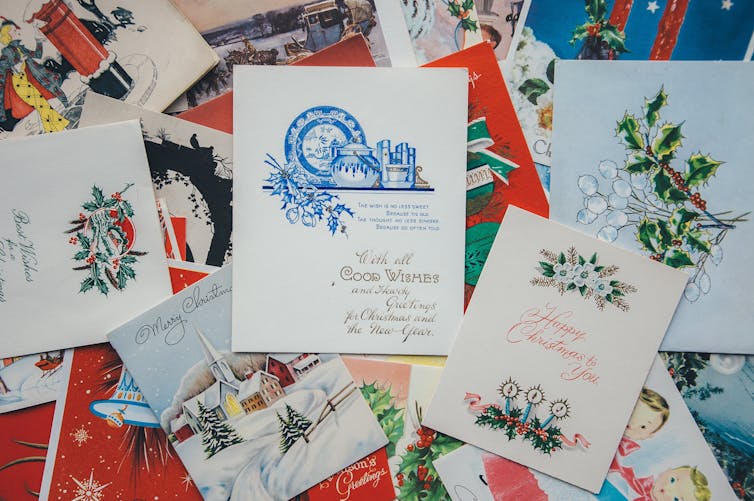
(Unsplash)
Joanne E. McNeish, Ryerson University
Forty years ago, the sending and receiving of Christmas greeting cards was one of the steps in declaring adulthood and establishing one’s own home. Part of becoming an adult was communicating the year’s events to family and friends.
In the Christmas letter that went with the card, there was some bragging about the good things in one’s life but it was also a vehicle to let people know about deaths or difficulties.
As Christmas became more about persuading consumers to buy, greeting card companies understood this. They grew their sales by offering greater varieties of cards, including boxed sets and charitable cards. Businesses began sending greeting cards to each other as a thank you for the work done together that year.
What had once been an important personal act of communication between the sender and receiver morphed into another job to do.
Today many of us use Facebook or Instagram to communicate the daily details of our life and to keep our network of family and friends up to date. Without any effort from us, Facebook even produces a video of a “year in our life” based on our postings. Where then does the holiday greeting card and Christmas letter fit in all of this digital communication?
A new vibrant craft industry
Large greeting card companies have seen revenue declines. But a smaller, vibrant craft industry in cards has emerged, and surprisingly, it’s attracting a new, younger customer. While the two generational cohorts before them valued the convenience and speed of digital communication, those born between 1981 and 2000 seek a slower and personal way of doing things.
Part of the reason for this is that adults under 40 years of age grew up with the many risks associated with digital information and devices such as fraud, loss of privacy and identify theft. This group has surprised many with their preference for retro technologies such as beautiful pens, paper books, paper bills and vinyl records.

(Kyle Glenn/Unsplash)
Regardless of Facebook or Instagram, we still long to have a hand in summing up the year’s events and sharing them with others. Thus, the digital age has also seen a growth in self-produced greeting cards. Instead of a letter documenting the year’s events, a single photo or photo montage are selected by the sender to convey the year’s events. Creating a paper card, writing a letter, or sending a picture postcard means we have an excuse to engage with the images in our digital “shoe boxes.”
The meaning of paper: More than the message
The resilience of paper documents, including greeting cards and Christmas letters, has been a surprise to many. Those who created digital content systems assumed that they could figuratively scrap the data off the paper, dump the data into a digital system and discard the paper. In reality, the paper was perceived by many to have meaning beyond its function as a data-carrying device.
Information presented on paper provides signals to us, the reader, about the importance of certain information, break points and is presented as the author intended. There is no computer, tablet or phone altering the author’s design and layout. Paper is the “device” that provides consistency between the writer and the reader.

(Annie Spratt/Unsplash), CC BY
Recorded information is considered permanent if it can meet three conditions: it remains usable, it is available for some period of time specified by the holder and it is under the control of the holder of the information. Digital information is dynamic and fluid, and while this is useful at times, more often it means that other people control the information, or even cause it to disappear altogether.
Collectively, we may be sending fewer cards, but those who do send them embrace it as part of the holiday experience and something that connects them more closely to those they care about. A paper card sent in the mail, chosen with the sender in mind, communicates more than the message inside. It speaks to the effort the sender made for the receiver and communicates the importance of that person in their life.
Research has explored how nostalgia works. It is evoked by sensory input, tangible objects that trigger memories of a homeland lost, people who are no longer in our lives or a longing for past events because they seem to be better in some way than the present. Greeting cards and Christmas letters support our memories of people and places.
Unlike digital information, some paper cards are saved long after their receipt. Their ability to engage three or four senses (touch, smell, feel and sight) makes them powerful as memory aids and emotional triggers. I haven’t yet cried reading an email, but I will admit to shedding tears over a wonderful message handwritten in a card from my son, and which I have carefully saved along with other treasures from his childhood.
Who will you touch with a card or letter this holiday season?
Joanne E. McNeish, Associate Professor, Marketing, Ryerson University
This article is republished from The Conversation under a Creative Commons license. Read the original article.



